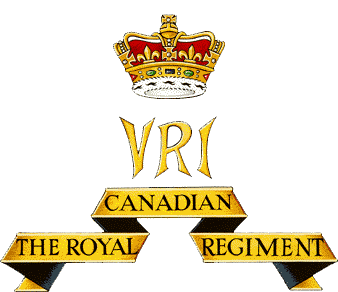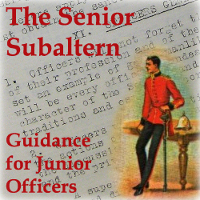
Standing Orders of
The Royal Canadian Regiment
(1935)
XXIII Battalion Parades
(a) Staff Parade. The Staff parade will be attended by the Drums, Band, the Warrant and Non-commissioned Officers of Headquarters and the Warrant and Non-commissioned Officers of Companies. The Parade will be formed up by the Regimental Sergeant-Major in the above order, Companies alphabetically, in column by the right. When covered by the R.S.M., rolls will be called by the Orderly Serjeants who will then fall in ten paces from the directing flank of the column and facing it. Reports will then be collected by the R.S.M., from the senior of each group. The Staff parade will then be formed into lion with three paces distance between ranks, and dressed by the right by the R.S.M. The parade will then be ordered to fix bayonets and slope arms and the R.S.M. will report the Parade to the Adjutant.
The Adjutant will then inspect the Parade; after inspection ranks will be closed and bayonets unfixed. The Band and Drums will be marched to their position on the Battalion parade Ground and the remainder will be dismissed to rejoin their respective Companies.
(b) The Battalion. Companies will fall in on their respective Parade Grounds where they will be inspected and proved in the usual manner.
The Regimental Sergeant-Major will call for or sound for markers who will fall in alphabetically on the Battalion Parade Ground and will be formed up by the R.S.M. for close column or for mass as ordered.
At five minutes before the hour fixed for parade, the Adjutant will order the “ADVANCE” to be sounded when Company Commanders will march their Companies on their markers.
XXIV The Colours
1. The Colours will be kept in the Officers’ Mess.
2. When the Colours are required on parade the following procedure will be carried out:
The Officer or Officers detailed to carry the Colours will proceed with the colour-party to the Officers’ Mess and will receive them from the Mess-President or a member of the Mess Committee. The Officer or Officers will salute the Colours, and the colour-party will present arms.
The Officer Commanding the colour-party will then march the party on to the parade ground and will halt in front of the centre of the battalion, facing it.
On the Commanding Officer’s order, “March on the Colour (or Colours)” the colour-party will march direct to its position, being received with the “Present”. During the salute the band will play the national Anthem if the King’s Colour is present, and if not, the Regimental March.
3. When both Colours are carried the colour-party will consist of one Company Serjeant-Major, one Sergeant and one Corporal or selected Private. When one Colour only is carried the colour-party will consist of one Company Serjeant-Major or Sergeant and one Corporal or selected Private.
4. When an escort – one company for the King’s Colour, two platoons for the Regimental Colour – is required the escort will, on arrival at the place where the Colours are kept, fix bayonets and open out leaving a sufficient interval in the centre for the colour-party.
When the Colours have been received by the Officers detailed to carry them the Officer Commanding the escort will give the commands “March on the Colour (or Colours)”, “Escort, Present Arms”. During the salute, the band, if present, will act as in para. 2.
On arrival at the battalion parade ground the escort with the Colours will march direct to their place on the parade, the battalion receiving them with the “Present.” During the salute, the band will act as in para. 2.
5. When the Colours are ordered to be marched off parade, the procedure will be similar to that of marching on, but in the reverse order.
On handing over the Colour or Colours at the Officers’ Mess, the colour-party will present arms and Officers will salute.
NOTE:--
Warrant and Non-commissioned Officers forming the colour-party will cover the points of their bayonets with cork to prevent the Colours being torn.
Standing Orders of The Royal Canadian Regiment (1935)
- The Commanding Officer
- An Officer in Temporary Command
- The Second-in-Command
- Officers Commanding Stations
- Officers Commanding Companies
- Seconds-in-Command of Companies
- The Adjutant
- The Signalling Officer
- The Quartermaster
- Subaltern Officers
- Officers Generally
- Warrant Officers
- The Regimental Sergeant Major
- Orderly Room Clerks
- The Sergeant Cook
- The Sergeant-Tailor
- Non-Commissioned Officers Generally
- The Band
- Employed Men Generally
- Officers' Servants
- Married Soldiers
- Soldiers Generally
- Battalion Parades
- The Colours
- Passes
- The O'Leary Collection; Medals of The Royal Canadian Regiment.
- Researching Canadian Soldiers of the First World War
- Researching The Royal Canadian Regiment
- The RCR in the First World War
- Badges of The RCR
- The Senior Subaltern
- The Minute Book (blog)
- Rogue Papers
- Tactical Primers
- The Regimental Library
- Battle Honours
- Perpetuation of the CEF
- A Miscellany
- Quotes
- The Frontenac Times
- Site Map
QUICK LINKS

- The Senior Subaltern
- Staff Duties and the Young Officer
- How to Write Effective English
- Notes and Quotes - Staff Duties
- Advice to Officers (1782)
- Mess Rules of the Infantry School (1884)
- A Dozen Military Epigrams (1901)
- How The Loafer's Bred (1904)
- The Promotion and Examination of Army Officers (1904)
- A Few Tips for Officers, Before and After Joining (1906)
- Standing Orders of The RCR (1910)
- Standing Rules for Officers' Messes of The RCR (1913)
- The Young Officer's Guide to Knowledge (1915)
- The Duties of an Officer (1916)
- An Open Letter to the Very Young Officer (1917)
- Advice to a Young Officer (1917)
- Battalion Duties; Officers, NCOs, and Soldiers (1917)
- Pleasing Infantry Brigadiers (1917)
- Role and the Responsibilities of the CO in a Battalion Mess (1917)
- The RCR, "A" Company Standing Orders (1918)
- Some Staff Duties (1923)
- An Officer's Code (1925)
- Hints on Promotion Exams (1925)
- On Writing Appreciations (1926)
- The RCR; Rules for Officers' Messes (1927)
- Morale And Leadership (1929)
- RCSI Hints for Young Officers (1931)
- RCSI Notes on Drill (1931)
- The Study of War by Junior Officers (1932)
- Self-Training (1934)
- "The Problem of the First Ten Years" (1934)
- Standing Orders of The RCR; 1935)
- Customs of the Service (1939)
- Drill and Discipline (1939)
- Leaders Win Where Commanders Lose (1939)
- The Officer and Fighting Efficiency (1940)
- Officers' Mess (RCAF, 1940)
- The Duties of an Officer (1942)
- Comrades in Arms (1942)
- Example Standing Orders - Subalterns (1942)
- Hints for Newly Commissioned Officers (1943)
- Completed Staff Work (1943)
- FOLLOW-ship (1943)
- Hints for Junior Officers (1945)
- Officer-Like Qualities (1948)
- Military Writing (1948)
- An Analysis of the Sub-Unit Commander (1949)
- Leadership (1950)
- Neptune's Notes (undated, 1950s-60s)
- Thinking and Writing (1953)
- Examination Tactics (1953)
- Officers (1954)
- On Writing Examinations (1954)
- Customs of the Army (1956)
- 1st Bn, The RCR, Senior Subaltern (1956)
- Pigs Have Wings (1960)
- Leadership and Man Management (1960)
- Officers (1964)
- 1RCR - The Sergeants' Mess - "Tips" (1971)
- 2RCR Junior Officer's Handbook (1973)
- How to be a Successful Subaltern (1978)
- Foreword to the Infantry Journal, No. 8 (1979)
- Do You Appreciate the Finer Points of Life? (1980)
- The RCR Regimental Standing Orders - Senior Subaltern (1992)
- Infantry Company Command (2016)
- A Miscellany of Advice for Subalterns
- The Young Officer and the NCO - Quotes
